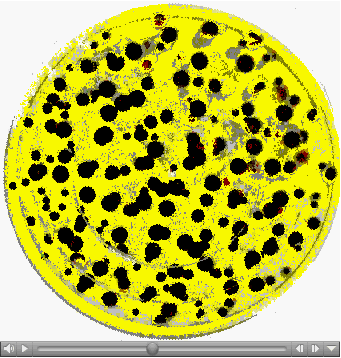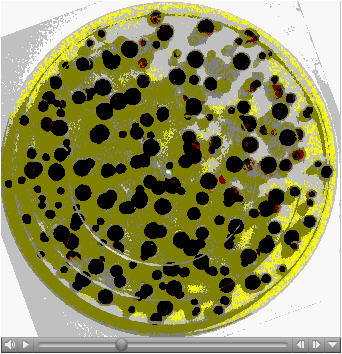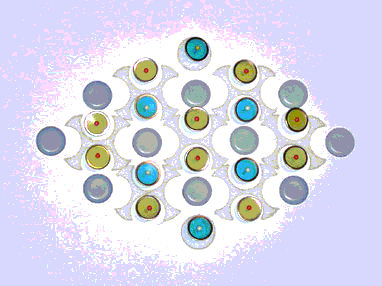View current page
...more recent posts
Paul Slocum has an interesting post up about archival issues and art DVDs. We sold two DVDs out of my show at And/Or Gallery, the space he and Lauren Gray run in Dallas (go, us!) and now business details are being attended to. First Paul's post and then my thoughts follow:
With our first show at And/Or I was really surprised to learn that video does sometimes sell ó we sold both of Tomís videos.Both DVDs I sent Paul were editions of five. (They didn't actually have Sharpie writing but nice printed labels.) There are trust issues that go each way between buyer and seller with the sale of multiples, the more so when both parties essentially own the means of production. I remember an artist friend of mine got a detailed contract from a prospective purchaser who was an attorney, trying to limit my friend's rights with regard to future production of a digital print. My friend refused to sign it and the attorney said "Oh, OK" and bought it anyway. I haven't investigated the costs of using the professional replicating houses, but I can't say Paul's way--selling a CD-ROM that allows the (tech-minded) buyer to make replacements--is any less acceptable than having a "pro" burn your DVD and then and then adopting an "all sales final" approach. I don't know what kinds of arrangements the big galleries make for such sales, and would welcome thoughts from anyone who doesn't think this is a taboo subject.
I didnít really expect the video pieces to sell, so I had to scramble to figure out archiving issues with DVDs. For most artists that we would show, getting a DVD produced would be cost prohibitive, so everythingís going to end up being a DVD-R. And how long these will last is unknown. Iíve read that playing burned media reduces its lifetime. ["I've never read that," Tom says nervously.] Iím not sure this is true, but if it is, DVD-Rs repeating over and over in a collectors home could have short lifespans. And using the wrong kind of marker could reduce its life. [Not Sharpies, I hope. --tm] Or a minor scratch.
Rather than go to great lengths to test DVD-Rs and research all the details of archiving, Iíve decided to take a ďfair useĒ approach instead. First of all, I archive all DVDs that we sell via ISO images. If the collectorís DVD fails, then we can replace the DVD. But as a secondary backup, I burn those ISO images onto a CD-ROM that comes with the purchase, and suggest that the buyer copy this data to their own computer and keep it safe. It seems a bit much to instruct the collector on how to rip a DVD and burn a copy, but if they have the ISO image itís easy to burn a copy. Maybe this all seems like a little much, but I guess itís the role of the gallery to figure out this kind of stuff

I cleaned up the previous .mov, replacing most of the olive color with yellow. A little wobbly on the bottom edge, need to recrop the frames: [11 MB .mp4]
Superfast version, no sound: [.mov file stopped working -- thanks, Apple -- here is a 97 KB GIF] <== This is probably the keeper, what I had in mind all along. Viewing it double size is best, if you download it.

Spinning petri dish-like abstraction with high pitched drone. Letting it loop a few times to get the full lo-fi psych effect of the simulated Brownian movement/cell mitosis is recommended. In other words, your eyes have to acclimate before the Op effects kick in. [11 MB .mp4]
This is work in process--collaborative music pieces done with John Parker based on the tunes I did with the Macintosh SE:
"Toronto 1 (Brakin)" [mp3 removed]
"Toronto 2 (Sadsong)" [mp3 removed]
Another John Parker piece I animated
Update: "Personal 'anti-broadband ghetto' threshold": Just trying to keep the kilobytes per post down on this page, optimally in the 25-65 KB range, so the blog is viewable on dial-up. It's tempting to post higher-res images and more elaborate animations for the broadband elite, but the self-imposed limits for the page (e.g., no image wider than 580 pixels) force thinking in a more economic lo-fi way. [/self-satisfied explanation]
Update 2: The animation this post linked to has been changed to something a little peppier.



"Mutator OD Bass" [1.9 MB .mp3]. The Mutator is an analog filter unit with a very full, liquid sound. It is practically a synth unto itself. This piece uses a couple of repeating bass notes that are transformed by external audio and MIDI signals affecting the Mutator's LFOs and envelope followers. The drums are the only thing added, the rest is the Mutator and mostly done in real time.
(reposted with additional info.)
Update on my upcoming Williamsburg show: the title will be "Room Sized Animated GIFs." We'll be projecting a couple of them big on opposite sides of the room, with smaller ones looping on TVs along a third wall. Friday, May 5, at artMovingProjects.
We changed the date--it was originally Saturday, but the intermittent L train repair shutdowns make that day an iffy proposition in Wmsburg.

Animation based on John Parker flat work (see below).
